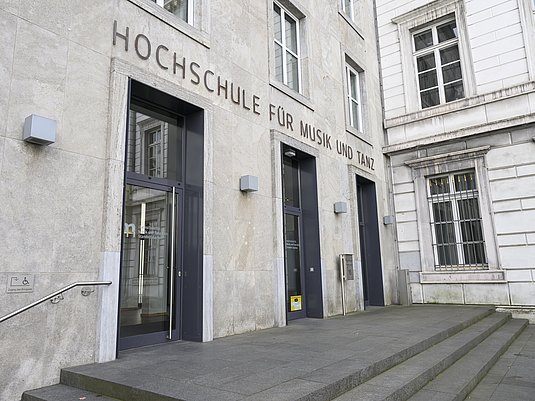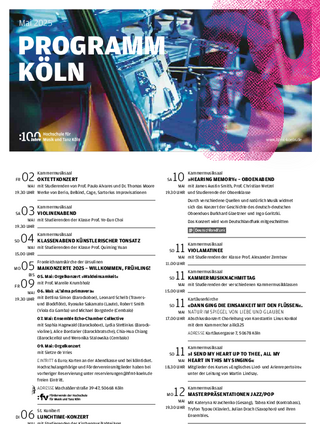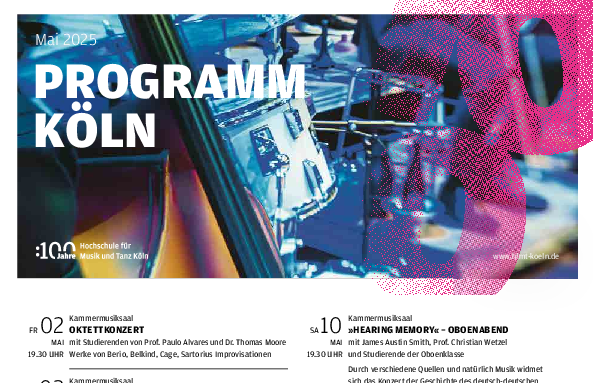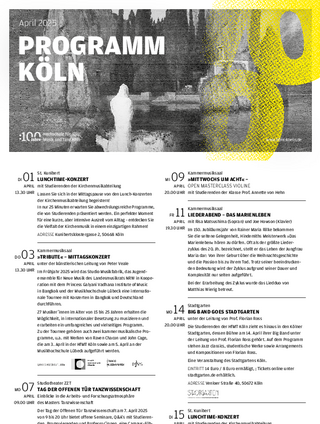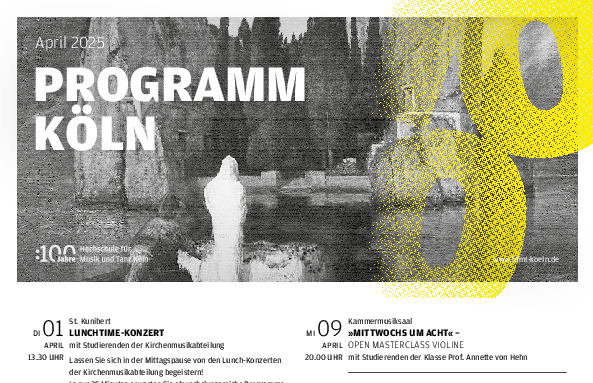Cologne
Harmony made in the city
Cologne sounds. And in many places. Here you can hear the buzz of voices of many students discussing humanities, natural and social sciences or winding down the day in one of the many parks. There you can hear the cawing of Cologne's parrots, Kölsch glasses being clinked together, the ringing of Cologne's churches and, above all, the peal of Cologne Cathedral.
In the midst of this sound play - and only a 10-minute walk from Cologne Cathedral - mainly silenced music and singing resound from overhead rooms. A wide variety of instruments resound, there is rehearsal and rehearsal, experimentation, concentrated learning, discussion and conducting.
This place is the Cologne University of Music and Dance.
Opening hours at the Cologne site
01.04.25 - 31.08.2025
01.04.25 until 31.07.2025
- Monday - Friday: 08:00 to 22:30 (lessons / practice time until 22:00)
- Saturday: 09:00 to 22:30 (lessons / practice time until 22:00)
- Sunday: 09:00 to 21:00 (lessons / practice time until 20:30)
01.08.25 to 31.08.2025
- Monday - Friday: 09:00 to 21:00 (lessons / practice time until 20:30)
- Saturday - Sunday: University closed
01.09.25 - 30.09.2025
01.09.25 to 30.09.25
- Monday - Friday: 08:00 to 22:30 (lessons / practice time until 22:00)
- Saturday - Sunday: 09:00 to 21:00 (lessons / practice time until 20:30)
Closed
- Easter | 18.04.2025 to 21.04.2025
- Labor Day | 01.05.2025
- Ascension Day | 29.05.2025
- Whit Sunday | 08.06.2025
- Whit Monday | 09.06.2025
- Corpus Christi | 19.06.2025
- Day of German Unity | 03.10.2025
- All Saints' Day | 01.11.2025
- Christmas break | 24.12.2025 to 01.01.2026
Events
Kammermusiksaal Köln
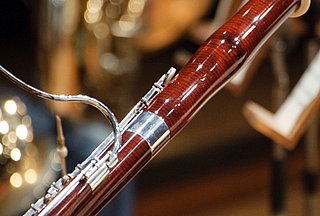
St. Kunibert Köln

Studio für elektronische Musik Köln

Kammermusiksaal Köln

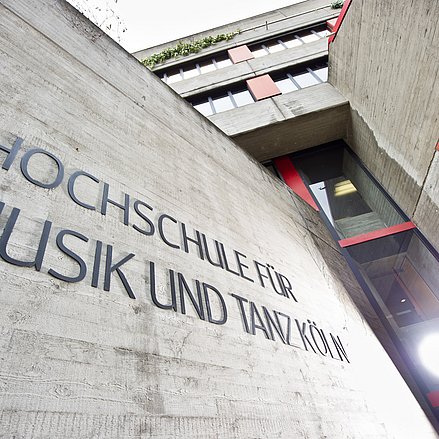

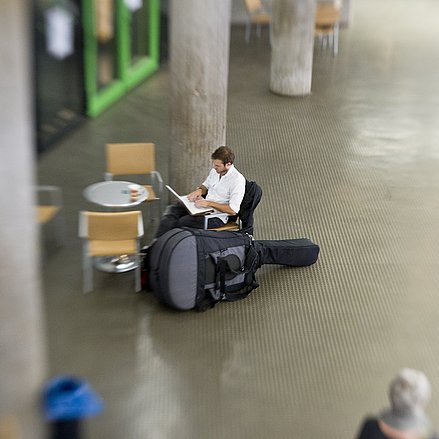
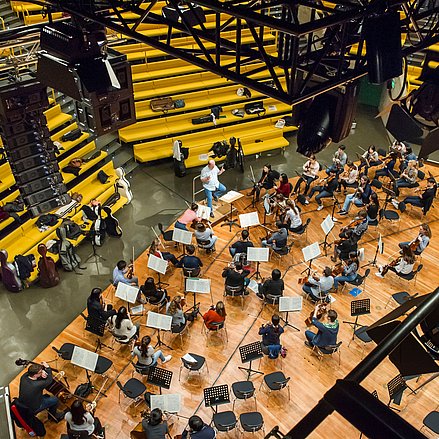

Tone and Location:Unter Krahnenbäumen 87.
The street name on which the Cologne University of Music and Dance is located is also resonant: "Unter Krahnenbäumen". To this day, one is not quite sure where the name comes from: either from the medieval expression "Cranenboym" for the juniper bush on which crows often settled, or from an old estate called "Zum Kranich". Something to do with migratory birds, that's for sure.
Among Cologne residents, the street is affectionately known as "UKB. In the cathedral city, it is considered the epitome of old Cologne. Many songs and texts have been written about it, about "streets like this one.
Today, songs are no longer written about the street. But songs are written in it, they are studied and interpreted with instrument and body. And in other respects, the Cologne University of Music and Dance is located exactly where it belongs: in the middle of a triangle formed by the World Cultural Heritage Cologne Cathedral, the Rhine and the lively Eigelstein district. Nature, culture and life: What could be greater sources of inspiration?
The locations of the university together offer
Venues
- Three concert halls, two chamber music halls
- One studio theater
- External venues: Urania Theater, Corpus Christi Church of the Ursulines
Technical facilities
- One lighting control room, two sound studios
Classrooms and overrooms
- Six organ rooms, about 90 overrooms, about 170 classrooms, five dance classrooms
Instruments
- 95 upright pianos, 241 grand pianos, instrument loans
Four libraries
Cologne is where I know the unknowns.
Melodies for a city of millions
With a population of around 1.1 million, Cologne is Germany's fourth-largest city and the third-largest student magnet - but if you ask the people of Cologne, it doesn't "feel" like it. This is not because there is less on offer here - on the contrary. It's much more because people here know "the unknowns".
After all, Cologne is a cosmopolitan city where people quickly make friends. People from 180 nations find a home here and look back together on 2,000 years of history of a city that was once founded as a Roman colony and developed from Colonia into today's Cologne.
You have your own beer, the Kölsch, your own dialect, the Kölsch, and your own music genres, which - who would have thought it - are called Kölschrock and pop. And while other cities can only claim four seasons, Cologne has a fifth: Carnival.
Even though the "Kölsch" is often emphasized here, it is rather the polyphony of the individual districts ("Veedel") that characterizes Cologne. Be it the inner city area with Cologne Cathedral, the 12 large Romanesque churches as well as the historic city center, Ehrenfeld with mosque and a lot of scene, the "Kwartier Latäng" with its student atmosphere, the lively Cologne Südstadt, the banks of the Rhine, the ever-changing Mülheim and many others: They all make up the special touch of a city where every pot finds its lid.
Live and study.
Cologne is a student city. About 10% of the city's population study and research at the more than 20 universities and colleges. Accordingly, Cologne also offers many opportunities for students: a wide range of sports, a diverse cultural program with discounts for students, student-influenced neighborhoods, and a variety of clubs, bars, concert venues, and events spread throughout the city. All this makes it easy to immerse yourself in the city.
Important addresses and contact persons for a good start in the Rhine metropolis can be found here on the left.
The HfMT is also part of the Cologne Science Circle. This is a network of the city's scientific institutions, both among themselves and with interfaces in the business world, with the goal of making Cologne known and strengthening it as a location for science.
Important contact points for students:
Dance, music and culture in Cologne
Culture is one of the mainstays of the vibrant metropolis of Cologne. Numerous sophisticated museums and theaters as well as an international music scene(Kölnarena, Musical Dome, Philharmonie, c/o pop, Opera, Stadtgarten, Loft) make the city an experience. Prominent musical representatives of all epochs and styles such as Jacques Offenbach, Karlheinz Stockhausen, Mauricio Kagel, Musica Antiqua Köln, Hans Werner Henzel, Engelbert Humperdinck, Bernd Alois Zimmermann, Max Bruch, BAP, etc., and a distinctive television and radio landscape consolidate Cologne's reputation as an international music and media metropolis. Cologne is also a city of reading and writing. Heinrich Böll, Günther Wallraff and Frank Schätzing are just a few of the cathedral city's well-known writers. A renowned flagship is lit.COLOGNE.
With the German Dance Archive, the city of Cologne also has one of the most outstanding research centers for dance in Europe. Numerous innovative and artistically high-ranking dance projects and the establishment of a Cologne Dance House as a performance and production venue for professional independent dance enrich the city's cultural scene.
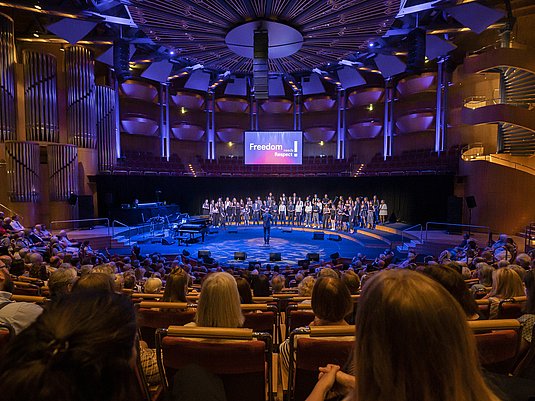
Music
Musically, Cologne offers an enormous repertoire and - in connection with this - also many performance opportunities for our students. This applies to the events at the university itself, but also to the numerous locations throughout Cologne, of which we can only present a few here:
ACHT BRÜCKEN | Music for Cologne
The "ACHT BRÜCKEN" festival is the successor to the former MusikTriennale, the largest music festival that combined classical, jazz and world music. Until 2010 it took place every three years. Today, the "EIGHT BRIDGES" annually provide sound art at the highest level.
c/o pop
Half industry meeting, half festival: c/o pop brings everything onto the stage every year and over five days that is or could possibly become pop culture. Established bands, newcomers and a lot of the unheard and unheard-of can be experienced throughout the city.
Classical Cologne
Classical, new and old music find a place everywhere in the city. Primarily in the many Romanesque churches of the city, the Cologne Cathedral or the Philharmonie. So that you don't lose your bearings here or miss exciting performances, the Klassik Köln calendar of events offers a fantastic overview.
JazzStadt Köln
Cologne Jazzweek in the Stadtgarten, Cologne Jazz Conference, the LOFT in Ehrenfeld, Jazz against the machine, WDR 3 Campus Jazz and so many more: Cologne has never claimed to be a jazz pilgrimage site, but it has done a lot to become one. Responsible for this? Above all, former and current students of the University of Music and Dance, who initiated many of the above-mentioned projects.
Dance & Theater
For decades, world-renowned artists have been working at the Cologne Opera. In addition to classical works, the program also includes many premieres and first performances.
Schauspiel Köln surprises with innovative and unique programs at various venues in the city and offers advanced training and workshops in theater pedagogy.
The independent Theater am Bauturm stages modern classics with social and political relevance. Since 2011, the (West) African theater festival africologne has been held there.
As a university theater, Studiobühne Köln presents student productions, guest performances, co-productions with independent Cologne groups, and hosts various festivals each year.
The Theater der Keller stages contemporary plays in cooperation with the Schauspielschule der Keller, often with a local connection.
tanz.koeln is part of Bühnen Köln and presents performances by internationally renowned choreographers and dance companies.
The German Dance Archive houses an archive, library, video library and a museum on the history and present of the art of dance.
The tanz.tausch festival brings together choreographers from different (federal) countries and presents a wide range of styles, themes and concepts.
In the cultural center Tanzfaktur there are performances, courses and workshops in different dance styles, from urban grooves to ballet.
Art
The Museum Ludwig, located directly behind Cologne Cathedral, shows Europe's largest Pop Art collection and an impressive Picasso collection as well as many works of German Expressionism, Russian avant-garde and contemporary art.
Old masters can be seen at the Wallraf-Richartz Museum. The city's oldest museum is one of Germany's great classical painting galleries.
Kolumba is the art museum of the Archbishopric of Cologne. In addition to the exhibitions, the building also impresses with its extraordinary architecture.
The Museum of Applied Arts (MAKK) exhibits European arts and crafts and jewelry collections. Another highlight is the modern design department with a focus on North America and Western Europe.
